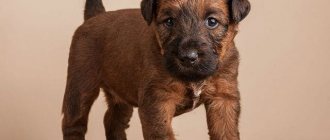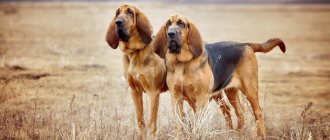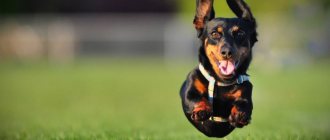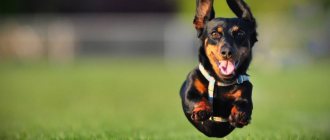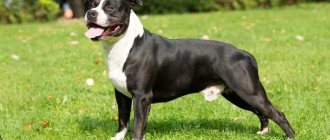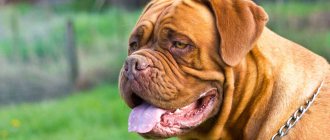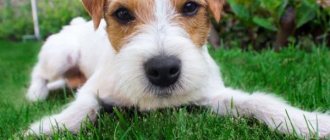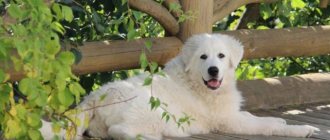Home » Dog Breeds
Classification Origin: USA
Class: according to the ICF classification group 3, section 3, number 286<
Color: black, blue (gray coat), red (pure or with black tint), fawn, brindle, white
Dimensions: height at withers: male – 46-50 cm, female – 44-48 cm
Lifespan: 12-15 years
Amstaff is a dog with a rather contradictory character, physically powerful and at the same time a sensitive and gentle dog, ready to take a leadership position and touchy in response to what he considers an unfair treatment.
For a dog to grow healthy, it needs either high-quality industrial food or a meat diet with the addition of vegetables and dairy products.
Amstaff is a wonderful companion and protector
The full name of the Amstaff breed is American Staffordshire Terrier. This is a wonderful companion and protector. The dog's wide, muscular chest stands out in the photo, while the animal has an elegant appearance. Amstaffs are known for their decisive character, endurance and at the same time sensitivity.
- 2 Psychology
- 3 Application
- 4 How to choose a puppy
- 5 Features of care
- 6 Combing
- 7 Walking
- 8 Food
- 9 Health
- 10 Characteristic diseases
- 11 Vaccinations
- 12 Mating
History of the American Staffordshire Terrier breed
American Staffordshire Terrier
The desire to see cruel and bloody scenes has been observed in humans since time immemorial. The medieval English were no exception, who loved to have fun by staging dog fights with bulls, bears and wild boars. Most often, bulldogs and mastiffs were used for these purposes. The problem was that the dogs of these breeds were very large and not agile enough, which is why they often died from the blows of the hooves or horns of angry opponents.
The desire to “modernize” the dogs’ fighting qualities forced the owners to engage in breeding work. Terriers turned out to be the best candidates for crossing with bulldogs: the dogs are active, agile and, most importantly, very smart. Thus, at the very beginning of the 19th century, bull terriers appeared that perfectly combined the best features of their predecessor breeds. After the ban on bullfighting, which the English Parliament passed in 1835, dog fighting came into fashion, and the successful “terrierization” of the breed made it possible to obtain a phenotype that was perfectly suited for this purpose. Variants of the name of the breed - Staffordshire Terrier, Pit Bull Terrier - were gradually transformed and consolidated in the single name of the English branch "Staffordshire Bull Terrier".
English migrants who rushed to America after the North's victory over the South in the Civil War brought a large number of animals to the continent. Brutal dog fighting, which by this time had already been prohibited on the islands of Foggy Albion, gained particular popularity in the New World. The main direction of breeding work remained the development and consolidation of the fighting qualities of dogs. The United Kennel Club, created at the very end of the 19th century in the state of Michigan, chose the development and improvement of the pit bull terrier breed as its main activity. The dogs bred here not only took part in battles, but were also successfully used to protect houses, farms, and hunt wolves.
American Staffordshire Terrier puppy
At the same time, the voices of those animal lovers who did not share the passion for dog fighting and paid more attention to exhibition work were heard louder and louder. They set about developing a standard and improving the appearance of the pit bull. As a result, a dog was obtained that looked very similar to a pit bull terrier, but was quite suitable for a “peaceful life.” They called it the Staffordshire Terrier, and it was under this name that the breed was recognized by the American Kennel Club in 1936. This led to the division of breeders into two camps. Some registered their pets exclusively as fighting American pit bulls, others gave preference to Staffordshire terriers and did not recognize pit bull terriers at all.
FCI officially registered Amstaffs in its registry under number 286 in May 1971. The following year, the American Kennel Club changed the name of the breed to “American Staffordshire Terrier,” emphasizing that the branches have certain differences - the “American” is on average 8 cm taller at the withers and 5 kg heavier than the “Englishman”.
The first Amstaffs came to Russia in the 80s of the last century and very quickly gained popularity. High demand led to the fact that unscrupulous breeders did not bother to control either the appearance of the resulting dogs or their mental stability. This is precisely the reason why Staffordshire Terriers began to be considered “killer dogs”. Such a bad reputation lies entirely on the conscience of the owners, who either through stupidity and inability, or deliberately raised aggressive and ferocious dogs. Today the trend has changed, Staffords confidently occupy the niche of companion dogs.
History of the origin of staffs
The long history of Staffordshire Terriers dates back to distant England, where the ancestors of this breed, the English Bulldogs, grew up. The ancestors of the Staffs were widely valued for their fighting qualities. They were originally used as rat arena fighters. Later, when dog fights appeared, their organizers needed a more agile dog. And as a result of crossing bulldogs and terriers, pit bull terriers arose, combining the tenacity of the former and the agility of the latter. When dog fighting was banned, the new breed did not disappear: its brave representatives were very fond of the townspeople. The fashion for pit bull terriers lasted for a long time. Among wealthy and noble people it was considered prestigious to have such a famous pet at home.
Amstaff appearance
American Staffordshire Terrier with undocked ears
The American Staffordshire Terrier is a strong dog with well-developed bones and pronounced athletic muscles.
The height of males at the withers is 46-48 cm, females - 43-46 cm. Body weight - 25-30 kg and 22-25 kg, respectively.
Head
Medium length, but very voluminous and wide. The skull is almost flat, wide between the ears, almost square in shape. The occipital protuberance is poorly expressed. The transition from the muzzle to the slightly convex forehead is clearly visible. The muzzle is of medium length, the ratio to the length of the skull is 1:1. The chewing, buccal and parietal muscles are prominent and dense. The lips cover the jaws, but do not look saggy.
Nose
The lobe is black, rather large in size with well-opened nostrils.
Jaws
The jaws of the American Staffordshire Terrier are very powerful, strong, and dense.
Ears
Located high and wide. Amstaffs have options for both sharply and short-cropped ears and undocked ears. The latter option is rated higher if the shells are naturally short and stand very firmly on the cartilage (the so-called “rose”).
Eyes
Set low and wide apart, round in shape. The color of the iris is dark. Eyelids are pigmented.
Teeth
The American Staffordshire Terrier's teeth are large and white. The incisors on the lower jaw are arranged linearly. Scissor bite.
Neck
Strong, with well-developed muscles, expanding evenly towards the withers. Length – average. No folds or sagging are observed.
American Staffordshire Terrier muzzle
Withers
The Amstaff's withers are clearly defined, muscular, with a smooth transition into the line of the back. The shoulder blades are long, pressed to the back.
Back
Running amstaff
Short, straight, the line slopes slightly towards the croup. The muscles are well developed.
Croup
Slightly sloping, moderately rounded. Wide and muscular.
Rib cage
Wide and deep, rounded ribs.
Tail
The Amstaff's tail is straight and short. Set low, slightly tapering towards the end. When excited, stands erect.
Limbs
The forelimbs, when viewed from the front, are parallel and straight, set wide apart. Moderate high anteriority is observed. The bones are powerful, the muscles are sculpted and athletic. The elbows look straight back and are pressed to the body.
The Amstaff's hind legs, when viewed from behind, are straight and parallel, with well-developed (but not excessive) muscles. The angles of the joints are well defined.
Paws
Arched, not large, round and collected.
Wool
amstaff at the exhibition
The American Staffordshire Terrier's coat is short, moderately thick, hard to the touch, and lies close to the body. Straight and shiny in appearance.
Color
Solid - from cream to black, but not white, as well as two-color, spotted, brindle or piebald. White markings are possible if they make up no more than 20% of the basic color tone of the Amstaff.
The gender of a dog is clearly manifested in its appearance.
Possible defects
Any deviations from the standard, depending on the degree of their severity, can be considered either shortcomings or defects.
Disqualifying faults for American Staffordshire Terriers include: cryptorchidism, flesh-colored nose, skewed lower jaw, undershot, deafness, long or docked tail, light eyes, and ambling.
Amstaff photo
Character of the American Staffordshire Terrier
If we talk about the character of the Amstaff, then there is hardly another breed of dog whose character would be described by such diverse, and sometimes completely opposite, epithets.
Amstaff with owner
Reliable, intelligent, loyal, endowed with a considerable amount of fun and even some playfulness, balanced and self-possessed - this is what lovers of the breed say about the Staffordshire. Aggressive and vicious - this is the assessment given by critics of the breed. But the latter character traits are associated in almost all cases with either inept or with education aimed at the formation of negative qualities.
Anyone who wants to have such an animal should firmly understand that the American Staffordshire Terrier is a very powerful dog with pronounced guard and fighting qualities. She will until the end protect not only the members of the family in which she lives, but also the integrity of the territory entrusted to her from any encroachment. With such inclinations, a properly raised Amstaff will show aggression only if it feels threatened from the outside. A dog's intuition is so strong that sometimes it seems that it reads the thoughts of your ill-wisher. The Staffordshire Terrier attacks very often without “declaring war.” Barking and growling are for weaklings. The dog fights until complete victory; it is almost impossible to stop him. In “peak” situations this is quite acceptable, but in everyday life such behavior can cause many problems, so proper education and skillful socialization of the dog are very important. By letting your puppy know that all members of your family are his friends, you will eventually get a loving, attentive and devoted friend.
Initially, one of the goals in developing the Staffordshire Terrier breed was to obtain a dog that was best suited to perform the function of family protector. People of all ages can easily find a common language with Amstaff. For children, the dog will become a gentle, attentive nanny who will patiently endure all the little ones’ pranks. But you still shouldn’t leave your dog alone with very young children.
In a calm home environment, the American Staffordshire Terrier can be the sweetest creature, trying in every possible way to amuse and please its owner. But the authority of the latter must be indisputable, and only a fairly experienced owner can cope with such a strong spirit and body dog. In order to control the Amstaff and manage his natural instincts, desire alone is not enough - you cannot do this without professional knowledge and skills.
American Staffordshire Terrier with cat
Amstaff walks with a child
Education and training
The American Staffordshire Terrier is a dog whose upbringing and training should never be left to chance. From the very first day a puppy appears in your home, you need to clearly understand all the responsibility that you have taken upon yourself by getting this particular breed.
Got it!
The main thing at the first stage is to properly organize the socialization of the animal. You can start immediately after the end of the “vaccination quarantine”. Pay special attention to introducing your baby to other pets. A small nuance - for this purpose it is better to choose the most good-natured and affectionate pets (you probably know these in your yard or nearby). The puppy is very curious, and it is important that he only has pleasant memories from new acquaintances, since the fear he experiences will be remembered for a long time and will eventually develop into aggression. Surprisingly, a small Amstaff can even remember the breed of its offender. This is fraught with problems in the future.
Often, owners of Staffordshire Terriers, when raising a pet, resort to two extremes. They either allow everything or prohibit everything. Both are wrong. In the first case, when the dog grows up, you will look, to put it mildly, funny on walks with it. The sight of an owner trying in vain to restrain a powerful Amstaff that is tearing off the leash (even for peaceful purposes) is simply pitiful. In the second case, you will raise a coward. And from cowardice to anger there is only one step. And no one knows when your pet will do it.
Obviously, some people consider the American Staffordshire Terrier to be an unsafe dog. You must be prepared for the fact that during walks the reaction of passers-by may not always be adequate. Do not engage in arguments or explanations in a raised tone, the dog will sense your aggression and think that your opponent is dangerous. The consequences of such an assessment of the situation are not difficult to predict. The best way out is to pass by in compliance with all norms of peaceful coexistence.
Rope game
Otherwise, raising an Amstaff is not much different from interacting with dogs of other breeds. You need to do it from the very first day the baby arrives at home. The principle is very simple. It says: “What is possible is always possible; what is not allowed is not allowed under any circumstances.” What is good and what is bad must be explained patiently and persistently, but in no case using violence or punishment, without changing the rules of the game along the way.
Do not spoil your pet at least until you develop a stable behavioral stereotype in him.
Amstaffs are very smart and easy to train. The best results can be achieved by visiting special sites.
And the last thing: you don’t need to raise a monster out of a dog. It won’t make you cooler than “cool Walker.” Don't turn your pet into a tool for self-affirmation.
Exercise stress
Stafford puppies need to go for walks a lot. However, you should not drive your dog until he is exhausted, this will only harm him.
An attentive owner will determine when the dog is tired and it is time to return home.
On average, you need to walk your puppy for 40 minutes or more twice a day. At the same time, it is necessary to organize games for him with elements of education; agility .
From 4-5 months you can start visiting the training ground.
If a child spoils household things, looks for “adventures”, is mischievous and does not want to respond to commands, most likely he does not go out enough.
Unused energy spills out in the form of unwanted behavior.
After all, not only adults, but also Stafford puppies have quite a lot of strength; it is not so easy to take a photo in which the baby is sitting calmly.
If your baby spoils household things, is looking for “adventures,” is mischievous, and does not want to respond to commands, most likely he is not getting enough exercise.
Amstaff care and maintenance
Where's my beer?
The Amstaff is an unpretentious dog, and following simple rules will allow you to avoid many problems or, at least, minimize them.
Starting from puppyhood, you must systematically, in a timely manner, carry out preventive measures to combat parasites. Treatment for fleas, ticks, and deworming are performed using special medications selected depending on the age and weight of your dog. Vaccination is another procedure that is extremely necessary and should never be neglected. Notes on all vaccinations must be included in the veterinary passport of the American Staffordshire Terrier.
Caring for an animal's fur is easy. For combing, a special brush is used, which not only removes dead hair, but also massages the skin well. For daily hygiene procedures, you can use wet wipes (preferably without fragrances and hypoallergenic) or simply wipe your pet with a clean towel soaked in water. But it is not recommended to bathe the American Staffordshire Terrier often. This can harm both your dog's skin and coat. Don't forget to use special gels and shampoos designed for this breed.
Trim your dog's nails monthly. Amstaffs do not really like to have their nails done, so it will be better if the owner carries out this manipulation. And you can’t trust a stranger to brush your teeth with a special brush either. Don't forget to keep your ears and nose clean. Dryness and cracks in this area indicate health problems in the dog.
The American Staffordshire Terrier is a fairly active dog by nature, so be prepared to spend plenty of time interacting with it.
Regarding feeding, a number of important points should be highlighted.
- A strong skeleton requires a high content of the “building material” of calcium in the food, so vitamins containing this element must be present in the diet of the Staffordshire Terrier.
- Meat should predominate in the menu, which can be given both boiled and raw. The use of exclusively dry food is not recommended.
- The amount of food should correspond to both the age and gender, as well as the physical condition of the dog.
- The Amstaff diet should include cottage cheese, milk, and boiled eggs. It is recommended to add vegetables to porridges and soups. Meat and bone meal and bones (not tubular ones) are useful.
- Puppies need to be fed especially well so that they actively gain muscle mass.
Amstaff walks with owner
Vaccinations
Puppies are promptly vaccinated against infections such as parvovirus enteritis, distemper and others. The first vaccination is given when the Amstaff is 2 months old, the second - at three months.
To support immunity, vaccinations are subsequently given once a year. There are three basic rules here:
- the animal must be healthy;
- 14 days before, the dog is dewormed and treated for fleas and ticks;
- vaccination is carried out 2-3 months before mating to prevent negative consequences for puppies.
Animals are regularly vaccinated
Once a quarter the dog is given deworming medication. In warm weather, from the beginning of spring until the arrival of frost, the Amstaff needs treatment for fleas and ticks. Special medications and collars are provided.
Health and Diseases of the American Staffordshire Terrier
The American Staffordshire Terrier is a breed characterized by good health. These dogs are active and resilient. However, there are a number of diseases to which they have some tendency.
Ear placement on an American Staffordshire Terrier puppy
First of all, we can talk about hip dysplasia. The problem is common to almost all large dogs. This does not mean that all Amstaffs suffer from dysplasia, since a lot depends on diet, intensity of physical activity, as well as genetic predisposition. When buying a puppy, ask the nursery about the heredity of your chosen one. Find out how often this disease occurred in his ancestors, what was its development. No one will say for sure whether your dog will get sick or not, but some rough forecast, based on the information received, can be made.
Bloating due to indigestion is another problem that occurs in American Staffordshire Terriers. By contacting a specialist, you will find out which foods need to be excluded from the diet (or, conversely, added) in order to normalize your pet’s metabolism. Proper nutrition will help avoid the difficulties associated with obesity.
Amstaffs can also be genetically transmitted to a tendency to allergic reactions to a variety of irritants. Most often this manifests itself as redness of the skin and severe itching. In most cases, it is possible to accurately determine the agent only in a veterinary clinic.
Eye diseases such as retinal atrophy and cataracts can also affect American Staffordshire Terriers.
Modern veterinary medicine makes it possible to cure or at least minimize the consequences of a very large number of diseases. It is only important to detect them in time. Carefully monitor the condition of your pet: what his coat looks like, whether his ears and eyes are clean, how active he is, whether he has a good appetite, whether there are any problems with the discharge of natural needs. It won’t require any extra effort, but it will definitely bring the desired effect.
How to choose a puppy
Let’s make a reservation right away: if you want to buy a purebred Amstaff, then the options of the bird market or advertisements on the Internet are immediately and unconditionally dismissed.
The procedure for purchasing from a specialized nursery has been well established for a long time, and you should definitely be familiarized with it in detail, if, of course, we are talking about a place with a good reputation. In this case, it is important to know that when buying a dog it is better to enter into a formal contract. Sometimes the form of purchasing a puppy “under contract” offered to clients has a number of nuances that can infringe on the owner’s rights to both the dog itself and its future offspring.
The third option is to buy an American Staffordshire Terrier puppy yourself from an experienced and trusted breeder. In this case, experts recommend paying attention to the following points.
American Staffordshire Terrier puppy face
- When planning a show career for your dog, ask the owner of the bitch to give you the opportunity to observe the development of the babies. The Amstaff's future traits are best demonstrated at birth, on the third day of life and at the age of one month. It is unlikely that you will have time to see the baby on the first and third days, but the monthly period is worth studying more closely. It is at the age of thirty days that the small American Staffordshire Terrier is an exact miniature copy of what can grow out of it, subject to all the rules and conditions for raising dogs of this breed. Don’t take stories that the deficiencies visible at this age can be corrected with a massage, a special diet, or some kind of “dancing with tambourines.”
- American Staffordshire Terrier puppies, which have a lot of white in their color, may not have completely colored noses, eyelids and lips, but partial coloring should definitely be observed. This process is finally completed by 8 months of age (sometimes a little later). The color of the iris of the eyes acquires its final shade even later, so you need to be very attentive to the eyes of a soft blue color, especially if the puppy has a fawn-blue or red-blue coat color.
- The puppy's coat should be short, “velor”, without bald spots. Skin without ulcers and pustules.
- The ears should be clean, without any unpleasant odor. The eyes are clear, without signs of souring. Under the tail it is clean and dry.
- If you notice a small hernia during examination of your abdomen, do not be upset. This problem can be dealt with through simple procedures.
- A Staffordshire Terrier puppy at this age should weigh from 2.5 to 5 kg, look fairly well-fed, without protruding ribs or rumps. In addition to mother’s milk itself, the baby’s diet should already contain other dishes: kefir, cereal porridge, scraped meat, cottage cheese.
An interesting fact is that the bitch sometimes regurgitates recently eaten food to her puppies, and the kids happily pounce on such a treat. This is absolutely normal and is explained by natural instincts. Moreover, this behavior indicates a well-developed maternal instinct, which is highly likely to be inherited by all female puppies in this litter.
You are unlikely to buy the baby you like right away. The sale of an Amstaff is permitted after it reaches the age of 45 days and the owner of the bitch has completed the mandatory branding procedures and expert assessment. Your first visit to the nursery will be more of an informational nature, but it will not be superfluous to thoroughly prepare for it by collecting the maximum amount of information.
Types of colors
Staffordshire Terriers come in several color shades. Their coat can be either solid or spotted. If you take good care of it, it will not fade over time and will be smooth, silky, and shiny. This coat shimmers in the sun and makes your handsome four-legged dog even more cute and attractive.
Black color . Its second name, “Black Boston,” means the rich color of the coat, which does not imply any other tints even in the sun. The eyes of an Amstaff of this color are usually black, as are the nose, paws, and ears. In some cases, small white spots may appear on the head, back, and muzzle.
White color . It is rare to see a completely white Amstaff - usually its nose remains black, as does the color of its eyes. A pet of this color requires especially careful care: dogs love to roll around in the grass, which can leave a green pigment on their fur. Walking in the slush is also not good for the snow-white dog, and upon arriving home you should wash his paws and belly, which also easily collects all the dirt from the ground.
Blue color . The coat with blue and blue tints in Staffordshire Terriers harmonizes perfectly with the eyes of the same color found in young puppies. However, the color is not always uniform, and white spots are often visible on the paws, face and belly. Dogs with blue-tinged fur look especially impressive at shows.
Also no less common colors of the American Staffordshire Terrier are brindle with characteristic dark vertical stripes against a background of red fur; deer, which is characterized by the presence of stripes along the entire body of the dog, starting from the head; fur seal with dark chocolate-colored fur, which looks especially impressive in the sun’s rays; red or red, without impurities of black or gray.
Photos of Amstaff puppies
How much does an American Staffordshire Terrier cost?
Like most other dog breeds, the cost of an Amstaff puppy directly depends on which class it belongs to.
Prices for show-class animals that have good makings for a successful exhibition career range from 25,000 - 35,000 rubles and above. The gradation in this case is associated with the eminence of the parents, as well as the personal inclinations of the puppy, the degree of expression of the best traits of the breed.
Representatives of the breed class are cheaper - 18,000 - 25,000 rubles. These American Staffordshire Terrier puppies meet breed standards or have minor deficiencies. They are unlikely to become champions, but they are quite suitable for breeding.
Pit class is the cheapest. Prices range from 12,000 to 18,000 rubles. If you do not plan to become a breeder or spend time and money preparing your dog for championship shows, but just want to have a reliable friend and protector, the pit-class American Staffordshire Terrier will be the right choice.
In any case, no matter which puppy you choose, the responsibility for its happy future lies entirely with you.
Health
The Stafford dog breed has a strong immune system and rarely gets sick. However, it is impossible to say that Staffordshire dogs are insured against diseases.
Diseases
Among the probable hereditary pathologies:
- Lameness. The cause of the pathology is improper formation of the hip joint. More often observed in fighting Amstaffs.
- Deafness. This type of minor deafness is not dangerous for a dog: the animal gets used to it and lives a normal life. Individuals with complete deafness cannot be trained. Diagnosis of the disease becomes fatal for the Staffordshire Terrier.
- Licked granuloma. It is a wound on the skin that appears in response to constant exposure. How to determine pathology? If the Amstaff frequently licks and bites one area of the skin, it is worth checking for a wound. The disease is treated by superficial treatment.
- Turn of the century. The dog needs surgery.
Vaccinations
Vaccinations for Amstaff puppies begin at the age of 6-8 weeks. Before the procedure, the animal needs to be dewormed. The same vaccination is repeated after a month. Staffordshire dogs are vaccinated against rabies at 12 weeks (the procedure can be carried out at 9 months or a year).
The full list of vaccinations given to Amstaff dogs depends on the dog’s living conditions. If he is susceptible to ticks, he may want to consider getting a Lyme vaccine.
A Staffordshire Terrier usually tolerates all vaccinations well if he was previously healthy. After vaccination, the dog should not be bathed; it is recommended to limit contact with other animals.
